
PREV ARTICLE
NEXT ARTICLE
FULL ISSUE
NUMISMAGRAM MEDAL SELECTIONS: JANUARY 2020Jeremy Bostwick at Numismagram passed along these highlights from his New Year's upload of exonumia. In addition to the pieces below, this group—a rather broad assortment—includes two more rechenpfennigen Nürnberg, an absolutely blazing medal issued for the Apollo 11 mission and Moon landing, a couple Karl Goetz satirical bronze medals, a few attractive Art Deco pieces, an interesting aluminum plaque featuring three individuals important to Canadian history, a powerful piece honoring the children slain in the WWII Lidice massacre, a splendid Teddy Roosevelt repoussé pop-out badge on a Barber half dollar, and a few other great types. Visit numismagram.com/inventory for all of these new items. In addition, readers can take advantage of some reduced prices on some selections of inventory by checking out sale items listed at numismagram.com/sale. -Editor Jonathan Martin Reliquary Snuff Box
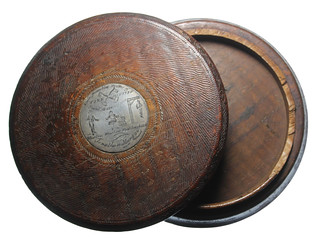 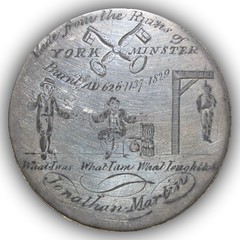 100920 | GREAT BRITAIN. York Minster wood & silver Reliquary Snuff Box Issued 1829. Condemning the arsonist, Jonathan Martin (133mm, 166.80 g). By P. Fossett in York. Circular wood box with tapered rims and patterned top and bottom panels, the top panel containing a silver central medallion hand engraved as follows: "Made from the Ruins of / YORK MINSTER / Burnt AD 626 • 1137 • 1829 / Jonathan Martin." Crossed keys above; in the middle, three images of Martin, the arsonist—standing and preaching the Gospel: "What I was"—sitting imprisoned with a ball and chains: "What I am"—hanging from the gallows: "What I ought to be." Choice Very Fine. Wood still features most of its intricate design; medallion once polished, now starting to re-tone; a few scattered marks; inner lip on base panel mostly broken, though some remains. Incredibly rare and interesting relic from the wood recovered in the aftermath of Martin's arson. Compared to other pieces of "hanging man" iconography, such as various trade tokens from the late 18th century, a bargain and a singular opportunity for such a tremendous and historic item. Snuff tobacco originated in the Americas, an alternative to that which was smoked and as somewhat of an analog to that which was chewed. The tobacco was ground and, during each administration, a pinch was placed on the finger or hand and then sniffed by the user. In Europe, the practice became a status symbol associated with the elite and also created the need for containers in which the snuff could be easily carried by the user. Snuff boxes, therefore, became an indispensable form of accouterment, and offered designs ranging from the more mundane to the rather elaborate. This particular snuff box was created from wood recovered from the parts of York Minster which were destroyed during a fire in 1829. Jonathan Martin had a history of extreme religious devotion and susceptibility to unpredictable outbursts. In between experiencing the deaths of his parents and wife, he served time in insane asylums and preached—first as a member of the Wesleyans, then unaffiliated as no denomination would support him. A year after remarrying in 1828, he suffered another mental breakdown, leading him to set a fire in the choir at York Minster, destroying a portion of the old cathedral. Owing to threatening notes which he left at the minster—containing his initials and address—it was rather easy to identify and apprehend him. During his subsequent trial, he was found guilty by a jury of a capital crime, though the judge countered this ruling, declaring him not guilty on account of insanity. Martin would then spend another stint in an asylum, this time for the remainder of his life until his death in 1838. Numerous reliquary snuff boxes from the ruins of York Minster were created right after this act—an event which captivated the attention of England. Though many share a similarity in size and overall design of the wood, this particular box stands as rather extraordinary in the placement of the central medallion, engraved and illustrative of the contemporary sentiments of Martin the arsonist. While a few others simply feature text and a mentioning of the event, this incredible piece portrays the three phases of Martin—first in the past, as a preacher wandering the streets; second in the present, as a criminal clad in shackles; third in the future, as a lifeless body hanging from the gallows. Though quite gruesome (and inaccurate, even if it were the desired outcome by those angry of his crime), it portrays how despised he was by his fellow countrymen. Incredibly rare and quite possibly the only of its type. A fascinating and very unusual item. -Editor To read the complete item description, see:
"Old Church Tijuana" Love Token
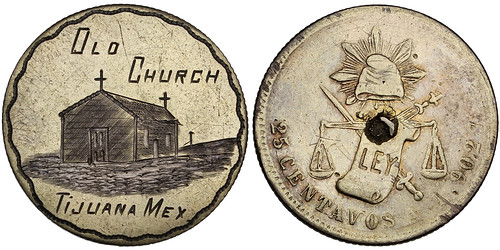 100982 | MEXICO. "Old Church Tijuana" silver Love Token. Engraved circa 1900 on an Alamos mint 25 Centavos (25mm, 5.97 g, 12h). "OLD CHURCH / TIJUANA MEX" above and below perspective view of the "Old Church" at Tia Juana (Tijuana); all within coiled border / Scroll inscribed LEY over scales and crossed sword and scepter; rayed Phrygian cap above. Edge: Reeded. Cf. KM 406 (for host coin). Engraving: Choice Extremely Fine; Host coin: Near Very Fine. Some scattered marks and soldering at center of the 'reverse.' An interesting piece of Mexicana and local art, all on a scarce mint host coin. Being borrowed from the early 18th century practice in Great Britain, and being related to even earlier forms of engraving on European coinage, "love tokens" were an extremely popular form of sentimental art that saw their high point in the United States in the mid-to-late-19th century, whereby coinage was smoothed down on one or both sides, and some form of initials, a message, and/or imagery was engraved so that it may be presented to a loved one. The most commonly encountered 'canvas' in the United States was the dime, and usually one from the Seated Liberty series. At their height, the U.S. Mint blamed an alleged shortage of dimes—a staple of most late-19th century transactions—on this craze. Rising again in the early-mid 20th century during the depths of despair that were the world wars, this form of coin art, usually referred to in this context as "trench art," would see another revival, offering soldiers a brief chance at escapism through sentimental creativity. This particular piece features the "Old Church" in Tijuana, an edifice which could not be located as still extant by this cataloger, but is featured—exactly as it was engraved here—on numerous postcards dating to the early 20th century. A charming representation of a humble southwestern church. An interesting and unique piece. Plenty of love tokens have carved initials or monograms, but "trench art" scenes like this one are uncommon. -Editor To read the complete item description, see:
Pygmalion Copper Jeton
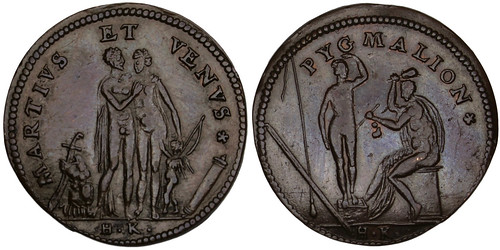 100942 | GERMANY. Nürnberg. Copper Jeton or Rechenpfennig. Issued circa 1600-1625. Mythology series: Mars and Venus/Pygmalion (28mm, 5.36 g, 12h). By H. Krauwinkel II. MARTIVS ET VENVS, Mars and Venus standing facing, embracing one another; sword and cuirass to left, Cupid, bow, and quiver to right / PYGMALION, Pygmalion seated left on basis, hammering and chiseling a sculpture to left. Neumann 32273; Mitchener 1624-5. Choice About Uncirculated. Pleasing brown surfaces; some minor striking weakness. Exceptional quality for the type. Rechenpfennigen, German for "accounting pennies," are similar to other tokens or jetons that could serve reckoning, gaming, or even semi-numismatic functions. In particular, the rechenpfennigen were made famous by their various manufacturers in Nürnberg (Nuremberg) from the mid-late 16th century to the early 18th century, with a host of themes used as subject matter. These topics included history, mythology, contemporary political affairs, and even satire. Though many were intended as aids in accounting and bookkeeping (with an accounting board and these tokens taking the place of an abacus or sliderule), they were also useful in other functions, such as in the world of gaming—as poker chips—or in commerce and monetary transactions—as a substitute for harder currency. A mythological type, this piece not only features Mars and Venus on the obverse, but also touches upon the story of Pygmalion, a sculptor famous in legend for falling in love with a sculpture produced by his own hand, it being so beautiful and realistic. In a modern reprisal, George Bernard Shaw's play of the same name sees phonetics professor Henry Higgins "sculpt" the diction of his student, Eliza Doolittle, thus "giving her life," in an upper class, social sense of early 20th century England. The musical and movie My Fair Lady remade Shaw's story, all pointing back to this original legend. Interesting item and story. A crude design, but appropriate for a jeton. -Editor To read the complete item description, see:
Scott Centennial Libertas Americana Token
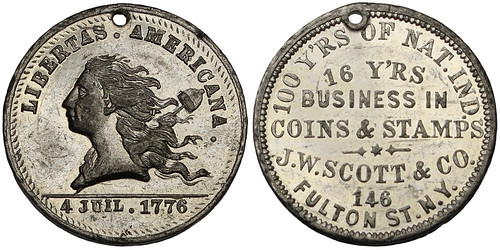 100937 | UNITED STATES. Libertas Americana/John Walter Scott white metal Token. Issued 1876. The centennial celebration (23mm, 4.29 g, 1h). LIBERTAS AMERICANA / 4 JUIL 1776, head of liberty left, with free flowing hair and Phrygian cap on pole / 100 Y'RS OF NAT. IND. / 16 Y'RS / BUSINESS IN / COINS & STAMPS / J. W. SCOTT & CO. / 146 / FULTON ST. N. Y. in seven lines. Edge: Plain. Miller NY-801; Rulau NY-NY-830. Mint State Details. Highly brilliant and lustrous, with some lightly scattered marks; holed at 12h for suspension. Restitution issue of the popular Libertas Americana type. Designed in part by Benjamin Franklin, the popular "Libertas Americana" motif was thought of as emblematic of the fledgling, newly-established nation—wild and untamed, hopeful and, most importantly, free. Here, the allegorical Liberty exhibits free-flowing, unkempt hair, while a Phrygian cap—an ancient symbol throughout Thrace and Anatolia that later came to represent liberty—tops a pole over her shoulder. During the country's centennial celebrations in 1876, this national iconography was restituted on many tokens of medals, such as this storecard for the New York-based coin and stamp dealer, J. W. Scott. Great numismatic Americana, produced by an important early coin dealer and publisher. -Editor To read the complete item description, see:
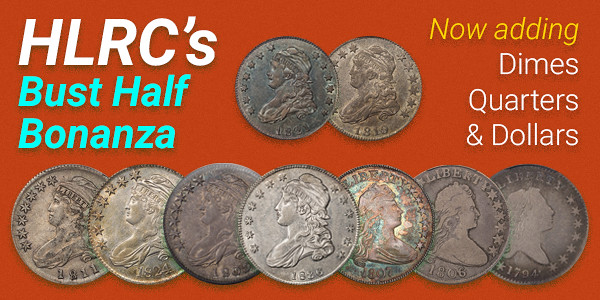 Wayne Homren, Editor The Numismatic Bibliomania Society is a non-profit organization promoting numismatic literature. See our web site at coinbooks.org. To submit items for publication in The E-Sylum, write to the Editor at this address: whomren@gmail.com To subscribe go to: https://my.binhost.com/lists/listinfo/esylum All Rights Reserved. NBS Home Page Contact the NBS webmaster 
|